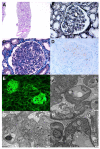New-Onset Kidney Diseases after COVID-19 Vaccination: A Case Series
- PMID: 35214760
- PMCID: PMC8880359
- DOI: 10.3390/vaccines10020302
New-Onset Kidney Diseases after COVID-19 Vaccination: A Case Series
Abstract
Various vaccines against COVID-19 have been developed and proven to be effective, but their side effects, especially on kidney function, are not yet known in detail. In this study, we report the clinical courses and histopathologic findings of new-onset kidney diseases after COVID-19 vaccination as confirmed via kidney biopsy. Five patients aged 42 to 77 years were included in this study, and baseline kidney function was normal in all patients. The biopsy-proven diagnosis indicated newly developed kidney diseases: (1) IgA nephropathy presenting with painless gross hematuria, (2) minimal change disease presenting with nephrotic syndrome, (3) thrombotic microangiopathy, and (4) two cases of acute tubulointerstitial nephritis presenting with acute kidney injury. Individualized treatment was applied as per disease severity and underlying pathology, and the treatment outcomes of all patients were improved. Since this is not a controlled study, the specific pathophysiologic link and causality between the incidence of kidney diseases and COVID-19 vaccination are difficult to confirm. However, clinicians need to consider the possibility that kidney diseases may be provoked by vaccines in patients who have renal symptoms.
Keywords: COVID-19; IgA nephropathy; kidney biopsy; kidney disease; minimal change disease; thrombotic microangiopathy; tubulointerstitial nephritis; vaccination.
Conflict of interest statement
The authors declare no conflict of interest.
Figures





Similar articles
-
New-Onset and Relapsed Kidney Histopathology Following COVID-19 Vaccination: A Systematic Review.Vaccines (Basel). 2021 Oct 29;9(11):1252. doi: 10.3390/vaccines9111252. Vaccines (Basel). 2021. PMID: 34835183 Free PMC article. Review.
-
IgA vasculitis presenting as nephrotic syndrome following COVID-19 vaccination: a case report.BMC Nephrol. 2022 Dec 15;23(1):403. doi: 10.1186/s12882-022-03028-7. BMC Nephrol. 2022. PMID: 36522629 Free PMC article.
-
New-Onset Acute Kidney Disease Post COVID-19 Vaccination.Vaccines (Basel). 2022 May 9;10(5):742. doi: 10.3390/vaccines10050742. Vaccines (Basel). 2022. PMID: 35632497 Free PMC article. Review.
-
IgA nephropathy after COVID-19 vaccination and analysis of reported cases.Heliyon. 2023 Jun;9(6):e17206. doi: 10.1016/j.heliyon.2023.e17206. Epub 2023 Jun 15. Heliyon. 2023. PMID: 37332909 Free PMC article.
-
Glomerulonephritis Histopathological Pattern Change.BMC Nephrol. 2020 May 18;21(1):186. doi: 10.1186/s12882-020-01836-3. BMC Nephrol. 2020. PMID: 32423387 Free PMC article.
Cited by
-
Type I IFN in Glomerular Disease: Scarring beyond the STING.Int J Mol Sci. 2024 Feb 21;25(5):2497. doi: 10.3390/ijms25052497. Int J Mol Sci. 2024. PMID: 38473743 Free PMC article. Review.
-
Atypical hemolytic uremic syndrome in a patient with HIV treated with eculizumab: A case report.IDCases. 2023 Jan 14;31:e01692. doi: 10.1016/j.idcr.2023.e01692. eCollection 2023. IDCases. 2023. PMID: 36699966 Free PMC article.
-
Minimal change disease and COVID-19 vaccination: Four cases and review of literature.Clin Nephrol Case Stud. 2022 Jul 21;10:54-63. doi: 10.5414/CNCS110924. eCollection 2022. Clin Nephrol Case Stud. 2022. PMID: 35923765 Free PMC article.
-
Glomerulonephritis following COVID-19 infection or vaccination: a multicenter study in South Korea.Kidney Res Clin Pract. 2024 Mar;43(2):165-176. doi: 10.23876/j.krcp.23.219. Epub 2024 Mar 20. Kidney Res Clin Pract. 2024. PMID: 38600028 Free PMC article.
-
Safety and effectiveness of COVID-19 vaccines in patients with IgA nephropathy: a retrospective cohort study from the TriNetX global collaborative networks.EClinicalMedicine. 2023 Nov 3;65:102306. doi: 10.1016/j.eclinm.2023.102306. eCollection 2023 Nov. EClinicalMedicine. 2023. PMID: 38021374 Free PMC article.
References
Publication types
Grants and funding
LinkOut - more resources
Full Text Sources
Miscellaneous

